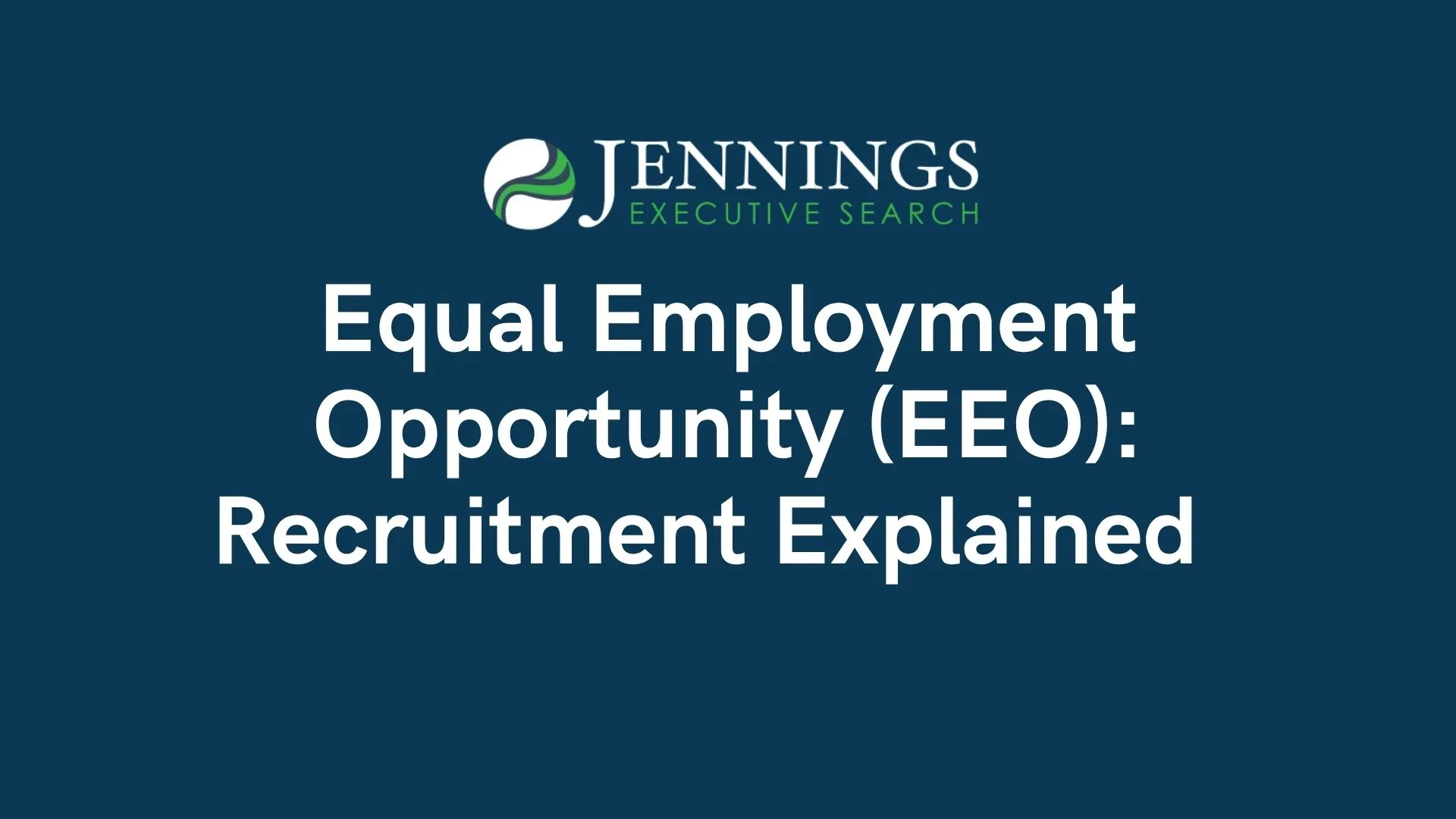Equal Employment Opportunity (EEO): Recruitment Explained
Discover the ins and outs of Equal Employment Opportunity (EEO) recruitment in this comprehensive guide.

Equal Employment Opportunity (EEO) is a principle that asserts that all individuals should have an equal chance to apply and be selected for a job, irrespective of their race, color, religion, sex, national origin, age, disability, or genetic information. This principle is not only a moral obligation but also a legal requirement in many countries, including the United States. In the context of recruitment, EEO plays a crucial role in ensuring a fair and unbiased hiring process.
Understanding the concept of EEO in recruitment is essential for both employers and job seekers. For employers, it helps in creating a diverse and inclusive workplace, which is known to enhance creativity, innovation, and productivity. For job seekers, it assures them that they will be evaluated based on their skills, qualifications, and abilities, not their personal characteristics or backgrounds.
Understanding EEO
The concept of Equal Employment Opportunity emerged as a response to the widespread discrimination in the workplace. It aims to promote fairness, equality, and justice in employment practices. EEO laws prohibit employers from discriminating against job applicants or employees based on protected characteristics, such as race, color, religion, sex, national origin, age, disability, or genetic information.
These laws apply to all aspects of employment, including recruitment, hiring, promotions, training, pay, benefits, and termination. They also protect employees from retaliation if they complain about discrimination or participate in an EEO investigation or lawsuit.
Key EEO Laws
Several laws enforce EEO in the United States. The Civil Rights Act of 1964, particularly Title VII, is the most significant EEO law. It prohibits discrimination based on race, color, religion, sex, or national origin. The Age Discrimination in Employment Act (ADEA) protects individuals who are 40 years of age or older from employment discrimination. The Americans with Disabilities Act (ADA) prohibits discrimination against individuals with disabilities.
The Equal Pay Act of 1963 mandates equal pay for equal work, regardless of the worker's sex. The Genetic Information Nondiscrimination Act (GINA) prohibits discrimination based on genetic information. These laws are enforced by the Equal Employment Opportunity Commission (EEOC), an independent federal agency.
Role of EEO in Recruitment
EEO plays a pivotal role in recruitment by ensuring that all job applicants are given an equal opportunity to compete for a job. It mandates that employers must not discriminate against applicants based on their protected characteristics. Instead, they should evaluate applicants based on their skills, qualifications, and abilities relevant to the job.
Moreover, EEO in recruitment encourages employers to take proactive steps to attract a diverse pool of applicants. This can include advertising job vacancies in diverse media outlets, partnering with organizations that serve underrepresented groups, and offering flexible work arrangements to attract individuals with different needs and lifestyles.
Job Advertisements
Job advertisements play a crucial role in EEO recruitment. They should be designed to attract a diverse pool of applicants and should not discourage or exclude individuals based on their protected characteristics. For instance, job ads should not specify a preferred age, gender, religion, or nationality, unless it is a bona fide occupational qualification (BFOQ).
Moreover, job ads should clearly state that the employer is an equal opportunity employer. They should also provide accurate and detailed information about the job, including the duties, qualifications, and application process, to help applicants make informed decisions.
Selection Process
The selection process is another critical area where EEO principles apply. Employers should use fair and objective selection methods to evaluate applicants. This can include structured interviews, skills tests, and reference checks. The selection criteria should be job-related and consistent for all applicants.
Moreover, employers should provide reasonable accommodations to applicants with disabilities during the selection process. This can include providing sign language interpreters for deaf applicants or modifying tests for applicants with learning disabilities.
Benefits of EEO in Recruitment
Implementing EEO in recruitment offers numerous benefits to employers. Firstly, it helps in creating a diverse and inclusive workforce, which is known to enhance creativity, innovation, and problem-solving. Diverse teams bring different perspectives, ideas, and experiences, which can lead to better decision-making and performance.
Secondly, EEO recruitment can enhance an organization's reputation and brand. Employers who are known for their fair and inclusive hiring practices are more likely to attract a diverse pool of talented applicants. They are also more likely to earn the loyalty and respect of their employees, customers, and the public.
Reduced Legal Risks
Complying with EEO laws in recruitment can significantly reduce legal risks for employers. Employers who violate these laws can face costly lawsuits, fines, and penalties. They can also suffer damage to their reputation, which can affect their ability to attract and retain talent. Therefore, EEO compliance is not only the right thing to do but also a smart business strategy.
Moreover, EEO compliance can help employers avoid costly turnover. When employees feel that they are treated fairly and have equal opportunities for advancement, they are more likely to stay with the organization. This can save employers the costs of replacing employees, which can include recruitment, training, and lost productivity costs.
Increased Productivity and Profitability
Research has shown that diverse and inclusive workplaces are more productive and profitable. When employees feel valued and included, they are more likely to be engaged, motivated, and productive. They are also more likely to contribute their unique ideas and perspectives, which can lead to innovation and growth.
Moreover, diverse teams can better understand and serve diverse markets. This can lead to increased customer satisfaction and loyalty, which can boost sales and profits. Therefore, EEO recruitment is not only a matter of fairness but also a matter of business success.
Challenges in EEO Recruitment
Despite its benefits, implementing EEO in recruitment can present several challenges for employers. One of the main challenges is unconscious bias, which can influence the recruitment process in subtle ways. For instance, recruiters may unconsciously favor applicants who share their backgrounds or characteristics, even if they intend to be fair and objective.
Another challenge is the lack of diversity in certain industries or occupations. For instance, some fields may have a low representation of women, minorities, or individuals with disabilities. This can make it difficult for employers to attract a diverse pool of applicants, despite their best efforts.
Overcoming Unconscious Bias
Overcoming unconscious bias in recruitment requires awareness, training, and proactive strategies. Employers can provide diversity and inclusion training to their recruiters and hiring managers to help them recognize and mitigate their biases. They can also use structured interviews and objective selection criteria to reduce the influence of bias in the selection process.
Moreover, employers can use technology to promote fair recruitment. For instance, they can use AI-powered recruitment tools that can screen resumes and shortlist candidates based on objective criteria, reducing the risk of bias. They can also use diversity analytics to monitor their recruitment process and identify any patterns of bias or discrimination.
Attracting Diverse Applicants
Attracting diverse applicants requires proactive outreach and engagement strategies. Employers can partner with organizations that serve underrepresented groups to advertise their job vacancies. They can also participate in job fairs, career events, and networking events to connect with diverse talent.
Moreover, employers can create inclusive job ads and career websites that reflect their commitment to diversity and inclusion. This can include featuring diverse employees, highlighting their diversity programs and initiatives, and using inclusive language and images. They can also offer flexible work arrangements, such as remote work or flexible hours, to attract individuals with different needs and lifestyles.
Conclusion
In conclusion, Equal Employment Opportunity is a fundamental principle that promotes fairness, equality, and justice in the workplace. In the context of recruitment, it ensures that all individuals have an equal chance to apply and be selected for a job, based on their skills, qualifications, and abilities, not their personal characteristics or backgrounds.
Implementing EEO in recruitment offers numerous benefits, including a diverse and inclusive workforce, enhanced reputation, reduced legal risks, and increased productivity and profitability. However, it also presents challenges, such as unconscious bias and lack of diversity, which require proactive strategies to overcome. Despite these challenges, EEO recruitment is a worthwhile endeavor that contributes to a fairer, more inclusive, and more successful workplace.
If you're looking to ensure your senior-level recruitment process aligns with EEO principles, Jennings Executive Search is here to help. With our extensive experience in filling high-profile positions such as Director of Pricing Strategy, Global Pricing Lead, and Sr. Manager of Pricing Strategy, we understand the importance of a diverse and inclusive hiring strategy. To discover how Jennings Executive can assist in elevating your recruitment to meet EEO standards and to learn more about our successful placements, Learn More about our services and expertise.
Recommended For You

From Pricing To Enterprise Analytics
How pricing teams can evolve into enterprise analytics engines and drive broader value.

How to Spot Pricing Talent When You’re Not a Pricing Expert
Hiring pricing talent without pricing expertise is possible—focus on role-specific skills, real business impact, and situational thinking to assess how candidates drive margins and decisions.

The Hidden Burnout Risk In Pricing Roles
Pricing burnout is real: high conflict, low control—fix it with authority and systems.

Talent Benchmarking for Pricing Roles
Align pricing role scope, title & comp with real market benchmarks before hiring.

The Pricing Analyst's Toolkit
The essential pricing analyst toolkit—and what truly drives impact in the role.

Why Your Pricing Team Can't Be All Strategy Or All Execution
Pricing teams break when strategy and execution are out of balance—here’s how to fix it.


